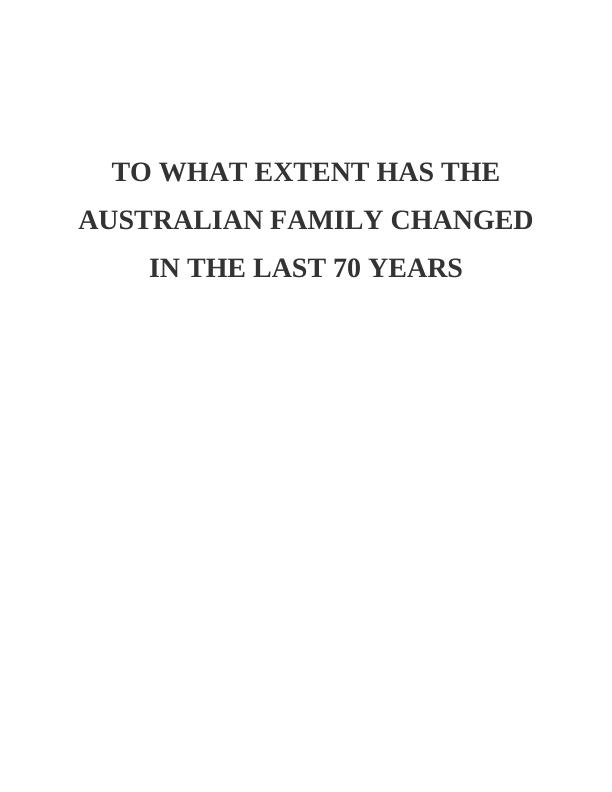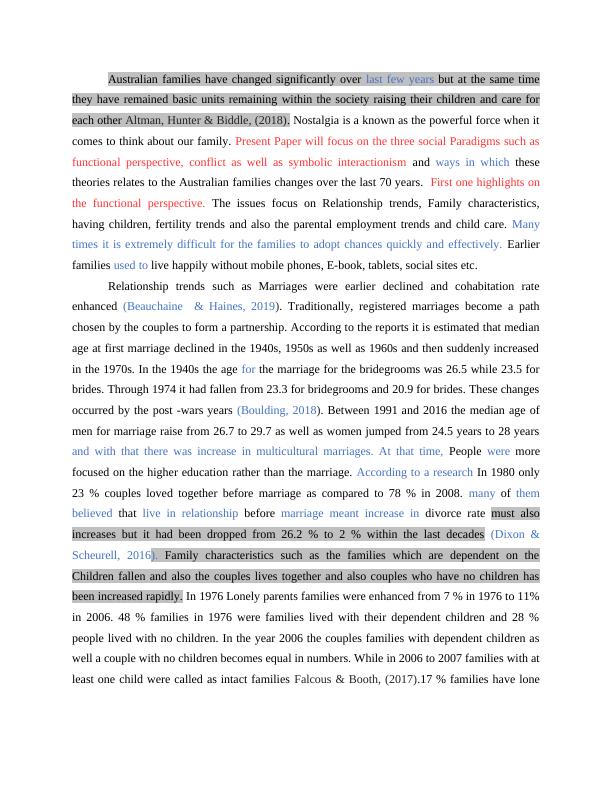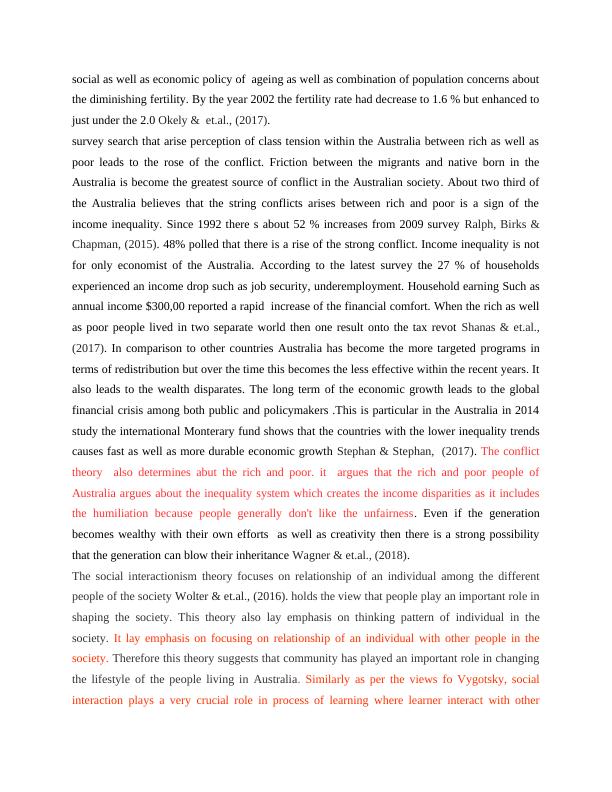Changes in Australian Families in the Last 70 Years
12 Pages2676 Words57 Views
Added on 2023-01-19
About This Document
This paper examines the changes in Australian families over the last 70 years, focusing on relationship trends, family characteristics, fertility trends, and the impact of social paradigms. It discusses the shift from traditional nuclear families to blended families, the increase in single-parent households, and the influence of technology and communication on family dynamics.
Changes in Australian Families in the Last 70 Years
Added on 2023-01-19
ShareRelated Documents
TO WHAT EXTENT HAS THE
AUSTRALIAN FAMILY CHANGED
IN THE LAST 70 YEARS
AUSTRALIAN FAMILY CHANGED
IN THE LAST 70 YEARS

Australian families have changed significantly over last few years but at the same time
they have remained basic units remaining within the society raising their children and care for
each other Altman, Hunter & Biddle, (2018). Nostalgia is a known as the powerful force when it
comes to think about our family. Present Paper will focus on the three social Paradigms such as
functional perspective, conflict as well as symbolic interactionism and ways in which these
theories relates to the Australian families changes over the last 70 years. First one highlights on
the functional perspective. The issues focus on Relationship trends, Family characteristics,
having children, fertility trends and also the parental employment trends and child care. Many
times it is extremely difficult for the families to adopt chances quickly and effectively. Earlier
families used to live happily without mobile phones, E-book, tablets, social sites etc.
Relationship trends such as Marriages were earlier declined and cohabitation rate
enhanced (Beauchaine & Haines, 2019). Traditionally, registered marriages become a path
chosen by the couples to form a partnership. According to the reports it is estimated that median
age at first marriage declined in the 1940s, 1950s as well as 1960s and then suddenly increased
in the 1970s. In the 1940s the age for the marriage for the bridegrooms was 26.5 while 23.5 for
brides. Through 1974 it had fallen from 23.3 for bridegrooms and 20.9 for brides. These changes
occurred by the post -wars years (Boulding, 2018). Between 1991 and 2016 the median age of
men for marriage raise from 26.7 to 29.7 as well as women jumped from 24.5 years to 28 years
and with that there was increase in multicultural marriages. At that time, People were more
focused on the higher education rather than the marriage. According to a research In 1980 only
23 % couples loved together before marriage as compared to 78 % in 2008. many of them
believed that live in relationship before marriage meant increase in divorce rate must also
increases but it had been dropped from 26.2 % to 2 % within the last decades (Dixon &
Scheurell, 2016). Family characteristics such as the families which are dependent on the
Children fallen and also the couples lives together and also couples who have no children has
been increased rapidly. In 1976 Lonely parents families were enhanced from 7 % in 1976 to 11%
in 2006. 48 % families in 1976 were families lived with their dependent children and 28 %
people lived with no children. In the year 2006 the couples families with dependent children as
well a couple with no children becomes equal in numbers. While in 2006 to 2007 families with at
least one child were called as intact families Falcous & Booth, (2017).17 % families have lone
they have remained basic units remaining within the society raising their children and care for
each other Altman, Hunter & Biddle, (2018). Nostalgia is a known as the powerful force when it
comes to think about our family. Present Paper will focus on the three social Paradigms such as
functional perspective, conflict as well as symbolic interactionism and ways in which these
theories relates to the Australian families changes over the last 70 years. First one highlights on
the functional perspective. The issues focus on Relationship trends, Family characteristics,
having children, fertility trends and also the parental employment trends and child care. Many
times it is extremely difficult for the families to adopt chances quickly and effectively. Earlier
families used to live happily without mobile phones, E-book, tablets, social sites etc.
Relationship trends such as Marriages were earlier declined and cohabitation rate
enhanced (Beauchaine & Haines, 2019). Traditionally, registered marriages become a path
chosen by the couples to form a partnership. According to the reports it is estimated that median
age at first marriage declined in the 1940s, 1950s as well as 1960s and then suddenly increased
in the 1970s. In the 1940s the age for the marriage for the bridegrooms was 26.5 while 23.5 for
brides. Through 1974 it had fallen from 23.3 for bridegrooms and 20.9 for brides. These changes
occurred by the post -wars years (Boulding, 2018). Between 1991 and 2016 the median age of
men for marriage raise from 26.7 to 29.7 as well as women jumped from 24.5 years to 28 years
and with that there was increase in multicultural marriages. At that time, People were more
focused on the higher education rather than the marriage. According to a research In 1980 only
23 % couples loved together before marriage as compared to 78 % in 2008. many of them
believed that live in relationship before marriage meant increase in divorce rate must also
increases but it had been dropped from 26.2 % to 2 % within the last decades (Dixon &
Scheurell, 2016). Family characteristics such as the families which are dependent on the
Children fallen and also the couples lives together and also couples who have no children has
been increased rapidly. In 1976 Lonely parents families were enhanced from 7 % in 1976 to 11%
in 2006. 48 % families in 1976 were families lived with their dependent children and 28 %
people lived with no children. In the year 2006 the couples families with dependent children as
well a couple with no children becomes equal in numbers. While in 2006 to 2007 families with at
least one child were called as intact families Falcous & Booth, (2017).17 % families have lone

others and 4 % were step families and also called blended families.3% were called as lone
parents families headed by their father.
From a functional aspect the role of Australian families from last 70 years in increasing
multicultural nation standards as well as values of society and also the people now depend on
their higher level of studies instead of focused on marriages but at the same time single parents
family also enhanced and no children families were increased Fiske, Hodge & Turner, (2016).
Conflict theory depends on the factors people are looking at now in present sense. good
reasons also associate with the conflict theory .Although Australia has community of Same sex
couples as it is a part of Official Australian statics since 1996. The estimated Information tells us
that there is high range of cohabitation relationship were enhanced in 1980 but today these are
the kinds of the relationship which are more common. In 1986 couplers have cohabitation
marriage is upto 5.7 % which is merely double in the year 2001 that is 12.4 %.there is a proof
that the cohabitation relationship are more likely to breakup within the six years of
commencement. These are the relationship establish in 1970 until today Jeong, (2017). This is
more vital as it shows that the children grow in the more solo family and also surveys shows that
they after 1986 there were enhanced in the solo parents as it is estimated that the growth in the
solo families children was arisen in June 2003 up to 2,068,800. Also since 1980 men's labour
forcer participation levels was also decreased. it is estimated that the when the women entered
within the labour force market in numbers then the men have dropped out of the labour force
Lang & Moleski, (2016). Also, the full-time employment also declined from 86.7 % in 1983 to
83.4% in 2003.Economic changes was also considered as there was high unemployment as well
as high inflation is one of the most characterised in the 1980s Lang & Moleski, (2016). In 1983
trend of unemployment peaked at 11.3 %and it undulated peaking at 11.9% in the year 1992 and
1993.it also reaches to the 5.2 % in January 2005.inflation level in the 1980 was on average
higher ad also the consumer Price index also rose from am average of 9.6 % from June 1980 to
July 1985 and also 3.4 % to average per year from July 2001 to 2005.here economic growth
also ,Measured in GRP per year from 1981 to 1985.fertility Trends also increases Lee & et.al.,
(2016).
Fertility rate in the Australia by 1980 had declined from 3.4 babies to 1.8 which is below the
replacement level of 2.2 .With the continual decline of the fertility rate in the late 1990s was
become the issue of fertility crises and it becomes apparent. This generated the alarm bells of the
parents families headed by their father.
From a functional aspect the role of Australian families from last 70 years in increasing
multicultural nation standards as well as values of society and also the people now depend on
their higher level of studies instead of focused on marriages but at the same time single parents
family also enhanced and no children families were increased Fiske, Hodge & Turner, (2016).
Conflict theory depends on the factors people are looking at now in present sense. good
reasons also associate with the conflict theory .Although Australia has community of Same sex
couples as it is a part of Official Australian statics since 1996. The estimated Information tells us
that there is high range of cohabitation relationship were enhanced in 1980 but today these are
the kinds of the relationship which are more common. In 1986 couplers have cohabitation
marriage is upto 5.7 % which is merely double in the year 2001 that is 12.4 %.there is a proof
that the cohabitation relationship are more likely to breakup within the six years of
commencement. These are the relationship establish in 1970 until today Jeong, (2017). This is
more vital as it shows that the children grow in the more solo family and also surveys shows that
they after 1986 there were enhanced in the solo parents as it is estimated that the growth in the
solo families children was arisen in June 2003 up to 2,068,800. Also since 1980 men's labour
forcer participation levels was also decreased. it is estimated that the when the women entered
within the labour force market in numbers then the men have dropped out of the labour force
Lang & Moleski, (2016). Also, the full-time employment also declined from 86.7 % in 1983 to
83.4% in 2003.Economic changes was also considered as there was high unemployment as well
as high inflation is one of the most characterised in the 1980s Lang & Moleski, (2016). In 1983
trend of unemployment peaked at 11.3 %and it undulated peaking at 11.9% in the year 1992 and
1993.it also reaches to the 5.2 % in January 2005.inflation level in the 1980 was on average
higher ad also the consumer Price index also rose from am average of 9.6 % from June 1980 to
July 1985 and also 3.4 % to average per year from July 2001 to 2005.here economic growth
also ,Measured in GRP per year from 1981 to 1985.fertility Trends also increases Lee & et.al.,
(2016).
Fertility rate in the Australia by 1980 had declined from 3.4 babies to 1.8 which is below the
replacement level of 2.2 .With the continual decline of the fertility rate in the late 1990s was
become the issue of fertility crises and it becomes apparent. This generated the alarm bells of the

social as well as economic policy of ageing as well as combination of population concerns about
the diminishing fertility. By the year 2002 the fertility rate had decrease to 1.6 % but enhanced to
just under the 2.0 Okely & et.al., (2017).
survey search that arise perception of class tension within the Australia between rich as well as
poor leads to the rose of the conflict. Friction between the migrants and native born in the
Australia is become the greatest source of conflict in the Australian society. About two third of
the Australia believes that the string conflicts arises between rich and poor is a sign of the
income inequality. Since 1992 there s about 52 % increases from 2009 survey Ralph, Birks &
Chapman, (2015). 48% polled that there is a rise of the strong conflict. Income inequality is not
for only economist of the Australia. According to the latest survey the 27 % of households
experienced an income drop such as job security, underemployment. Household earning Such as
annual income $300,00 reported a rapid increase of the financial comfort. When the rich as well
as poor people lived in two separate world then one result onto the tax revot Shanas & et.al.,
(2017). In comparison to other countries Australia has become the more targeted programs in
terms of redistribution but over the time this becomes the less effective within the recent years. It
also leads to the wealth disparates. The long term of the economic growth leads to the global
financial crisis among both public and policymakers .This is particular in the Australia in 2014
study the international Monterary fund shows that the countries with the lower inequality trends
causes fast as well as more durable economic growth Stephan & Stephan, (2017). The conflict
theory also determines abut the rich and poor. it argues that the rich and poor people of
Australia argues about the inequality system which creates the income disparities as it includes
the humiliation because people generally don't like the unfairness. Even if the generation
becomes wealthy with their own efforts as well as creativity then there is a strong possibility
that the generation can blow their inheritance Wagner & et.al., (2018).
The social interactionism theory focuses on relationship of an individual among the different
people of the society Wolter & et.al., (2016). holds the view that people play an important role in
shaping the society. This theory also lay emphasis on thinking pattern of individual in the
society. It lay emphasis on focusing on relationship of an individual with other people in the
society. Therefore this theory suggests that community has played an important role in changing
the lifestyle of the people living in Australia. Similarly as per the views fo Vygotsky, social
interaction plays a very crucial role in process of learning where learner interact with other
the diminishing fertility. By the year 2002 the fertility rate had decrease to 1.6 % but enhanced to
just under the 2.0 Okely & et.al., (2017).
survey search that arise perception of class tension within the Australia between rich as well as
poor leads to the rose of the conflict. Friction between the migrants and native born in the
Australia is become the greatest source of conflict in the Australian society. About two third of
the Australia believes that the string conflicts arises between rich and poor is a sign of the
income inequality. Since 1992 there s about 52 % increases from 2009 survey Ralph, Birks &
Chapman, (2015). 48% polled that there is a rise of the strong conflict. Income inequality is not
for only economist of the Australia. According to the latest survey the 27 % of households
experienced an income drop such as job security, underemployment. Household earning Such as
annual income $300,00 reported a rapid increase of the financial comfort. When the rich as well
as poor people lived in two separate world then one result onto the tax revot Shanas & et.al.,
(2017). In comparison to other countries Australia has become the more targeted programs in
terms of redistribution but over the time this becomes the less effective within the recent years. It
also leads to the wealth disparates. The long term of the economic growth leads to the global
financial crisis among both public and policymakers .This is particular in the Australia in 2014
study the international Monterary fund shows that the countries with the lower inequality trends
causes fast as well as more durable economic growth Stephan & Stephan, (2017). The conflict
theory also determines abut the rich and poor. it argues that the rich and poor people of
Australia argues about the inequality system which creates the income disparities as it includes
the humiliation because people generally don't like the unfairness. Even if the generation
becomes wealthy with their own efforts as well as creativity then there is a strong possibility
that the generation can blow their inheritance Wagner & et.al., (2018).
The social interactionism theory focuses on relationship of an individual among the different
people of the society Wolter & et.al., (2016). holds the view that people play an important role in
shaping the society. This theory also lay emphasis on thinking pattern of individual in the
society. It lay emphasis on focusing on relationship of an individual with other people in the
society. Therefore this theory suggests that community has played an important role in changing
the lifestyle of the people living in Australia. Similarly as per the views fo Vygotsky, social
interaction plays a very crucial role in process of learning where learner interact with other

End of preview
Want to access all the pages? Upload your documents or become a member.
Related Documents
Three Social Paradigms - PDFlg...
|12
|2689
|100
Reading Summary Assessment on Family, Ethics, Assessment, and Attachment Theorylg...
|8
|2481
|92
Changes in Australian Families: A Sociological Perspectivelg...
|8
|2851
|75
Market Research on Australian Household and Familieslg...
|10
|2440
|96
